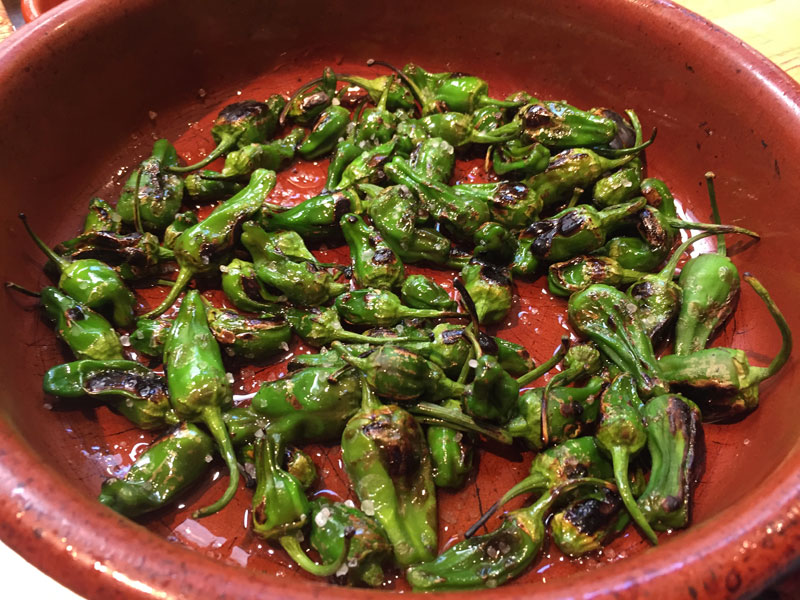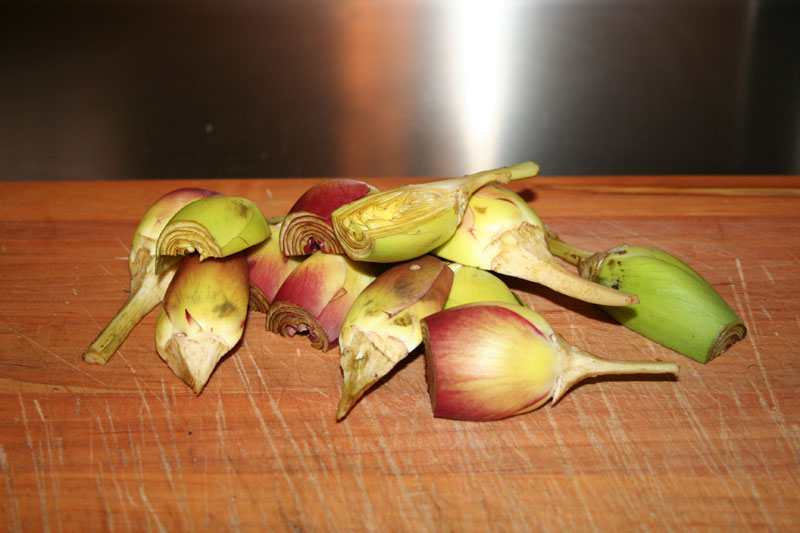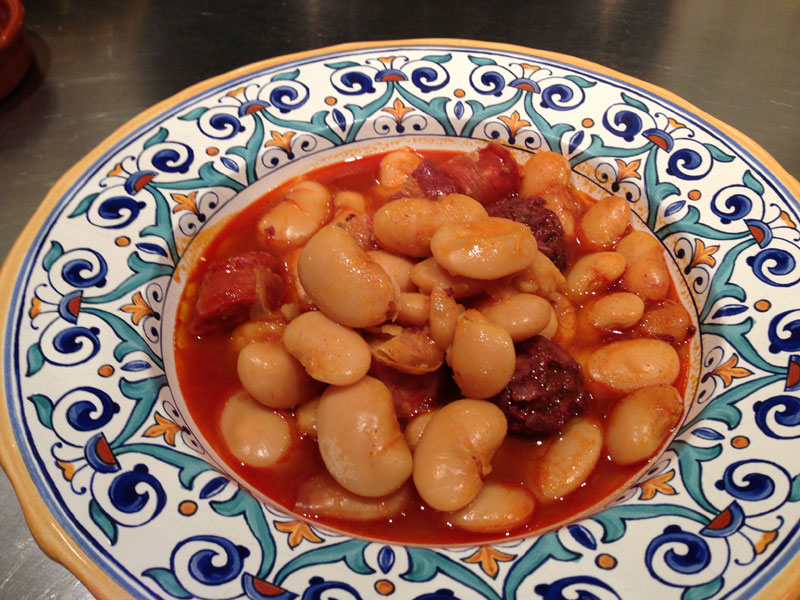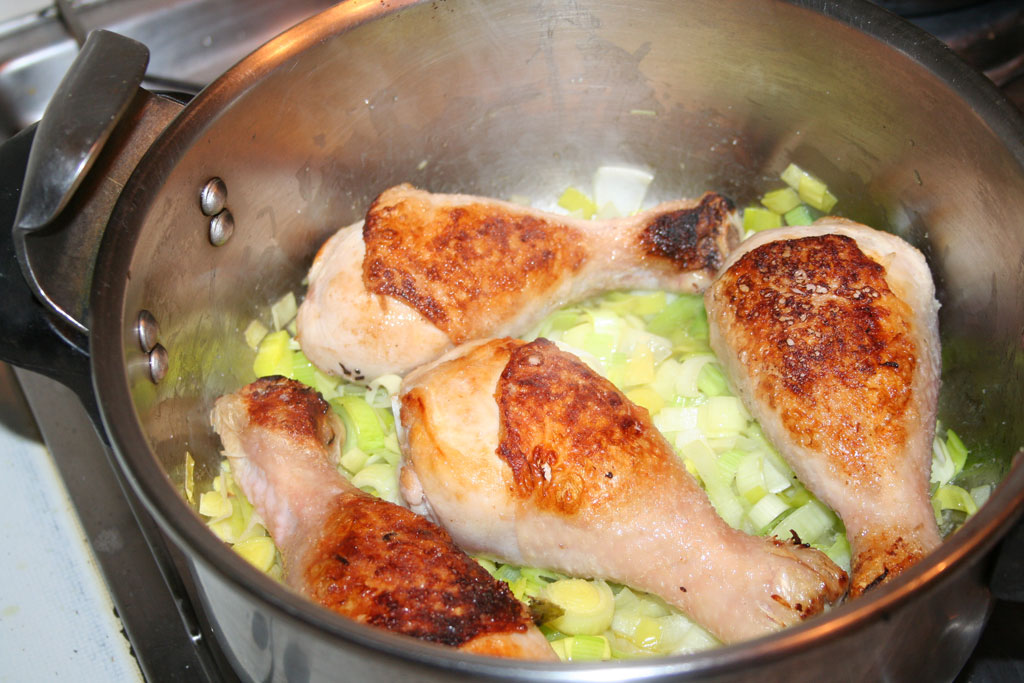|
Chopped, raw meat--when combined with the right elements--is a beautiful and primal--yet also elegant--dish, suitable for all occasions. I like to use a coulotte--also referred to as top sirloin--a petite cut that comes from the sirloin cap. It is commonly thought that using tenderloin is best for this dish but the filet or loin doesn't typically have that much flavor and it's also the most expensive of cuts. Ingredients (serves 6 as a first course):
-1.5 pounds of top sirloin/coulotte, cut into cubes (it's best to slice when the meat is very cold) -1 cup of gherkins, chopped -1/4 cup of salt-packed capers, drained and rinsed -1 quail egg per person -2 tablespoons chopped chives -2 tablespoons chopped chervil -2 tablespoons of chopped parsley -2 medium shallots, finely diced -1 tablespoon mayonnaise -1 teaspoon of freshly grated horseradish -2 tablespoons of dijon mustard -1 tablespoon lemon juice Combine everything but the eggs and mix well. Taste and adjust seasoning accordingly. Plate and crack a quail egg on each mound of tartare and serve with toast points.
0 Comments
This salad could not be simpler and goes with almost all greens. I like the bitterness of the radicchio paired with either little gem or other baby red lettuces. The cara cara oranges--in season during the winter months--are just fantastic but you could substitute regular oranges or in the summer stone fruit such as peaches or nectarines. Ingredients (serves 4-6):
-4 cups radicchio, chopped, washed and spun dry -3 cups little gems or baby red lettuces, chopped, washed and spun dry -2 large cara cara oranges, cut into slices, skin and pith removed -Extra virgin olive oil -Sherry or similar vinegar -Coarse sea salt Place the lettuces into a large mixing bowl. Sprinkle a tablespoon of coarse salt over the lettuces. Douse them with the Sherry vinegar, approximately 4-5 tablespoons. Dress liberally with olive oil, about 3-4 tablespoons. Mix well by hand. Taste and adjust seasoning as necessary. Place cara cara oranges slices on each plate and place lettuces on top. If you wanted to gussy up this salad more you could grate shreds of ricotta salata over the top. This is a classic seafood paella originating from the Valencia region of Spain. It was classically made with local ingredients such as rabbit, snails, mushrooms, artichokes and broad beans. The seafood version typically includes prawns, mussels, clams and often calamari. We start by making our soffrito or flavor base and then slowly add the other components, based on cooking time, to create an amazing almost dry rice stew (though it will not taste dry) that is one of the most festive and celebratory dishes you will ever see. The Valencia or bomba rice is critical as its short, fat grains are able to absorb an extraordinary amount of liquid while remaining firm to the bite. INGREDIENTS (serves 4-6): -1 paella pan (12 to 16 inches in diameter) or similar size cast iron pan (see Spanishtable.com or LaTienda.com for sources) -Good extra virgin olive oil (ideally from Spain) -1-tablespoon of pimenton picante (hot, smoked Spanish paprika) -1 large white onion, finely chopped -4 quarts of homemade lobster or fish stock (chicken stock is fine as well) -10 head-on gulf prawns -20 Manila clams -20 mussels -1/2 tablespoon saffron threads -2 cups Romano or green beans cut into 2 inch pieces (English peas work well too when available) -2 lemons, thinly sliced for garnish -1 cup tomato puree – I like the Mutti brand of “passata”. Whole, canned, San Marzano tomtoes, crushed by hand, also work well. -1.5 cups of “bomba” Spanish rice from Valencia -garlic aioli (optional, for mixing in with the rice). See the end of this post for how to prepare. Heat your paella pan over high heat until almost smoking (assemble across 2 burners if necessary. Add 4 tablespoons of olive oil to the pan. Add the onions and a generous pinch of salt and sauté until soft. If the onions start to burn turn down the heat and drizzle in more olive oil. Once soft and translucent (1-2 minutes) add tomatoes (lightly salt them) and stir. Cook for 1 minute or until the tomatoes release some liquid. Add the saffron to the liquid released by the tomatoes. Add the pimenton. Stir to combine and continue cooking for 15 seconds (do not burn the pimenton). Pour in all of the rice and stir through the pan. Turn the heat back up to high. Allow the rice to absorb the flavors of the soffrito for 30 seconds. Add the stock to just cover the rice and bring to a boil. Carefully stir the rice and distribute evenly through the pan. This is the only time you will ever stir the paella as we want it to cook evenly in one layer. Turn down the heat and maintain a medium simmer. The rice should be bubbling but not boiling aggressively. Cook for 15 minutes, adding more stock as needed each time the rice begins to look dry. Salt the paella throughout the cooking process, taking care to taste as you go. Add the green beans and the prawns and continue cooking for another 5 minutes, tasting the rice to check its progress and adding more stock as needed. Occasionally rotate and gently shake the pan to ensure even cooking. Turn the prawns over and add more stock as needed. When the rice tastes almost cooked through (18-20 minutes in) add the clams. Continue cooking until almost all the liquid is absorbed and the rice begins to look a bit “sticky.” Add the mussels. Continue cooking on low heat until you begin to smell a slight “burning.” The “socorrat” is developing. Allow this to continue for a few more minutes and then turn off the heat. Garnish with thinly sliced lemon pieces. Cover with a clean towel and let rest for 15 minutes. Serve the entire pan at the table family style. If you’ve cooked this dish well you will discover nice browned bits on the bottom of the pan. This is called the “socorrat” and is absolutely delicious and full of flavor. Garlic Aioli
This is so easy to make, especially with a hand- blender. You can also use a regular blender or food processor. Ingredients (serves 6): -1 whole egg -1 cup of sunflower or safflower oil -pinch of salt -2-3 cloves of garlic, chopped splash of lemon juice or Sherry vinegar Add the egg to the blender or container if using a hand blender. Be sure to use the blade attachment. Add a pinch of salt, the lemon juice or vinegar and the garlic. Pour in 1⁄4 cup of the oil and begin blending. Slowly drizzle in the rest of the oil until you have a thick emulsion. Cover and refrigerate until ready to use. Fresh aioli will keep refrigerated for 3 days. I absolutely love snacking on fegato or liver while my chicken is roasting in the oven. Here is a great way to serve it as an appetizer over bread. The addition of the shaved watermelon radish adds tartness and spice and helps balance the richness of the livers. Ingredients (serves 4 as an appetizer):
-1/2 pound very fresh chicken livers -2 tablespoons unsalted butter -1/3 cup balsamic vinegar -salt and pepper, to taste -extra virgin olive oil -parsley for garnish -watermelon radishes (optional), shaved on a mandolin into small discs. -crusty bread, lightly toasted and dressed with olive oil & a pinch of coarse sea salt Carefully trim/cut away any sinew and connective tissue from the livers and cut into small pieces, about 1/4 to 1/2 inch thick. Heat a sautee pan over medium-high heat with 2 tablespoons of olive oil and the butter. When almost smoking add the livers and cook for about 1 minute, turning often until lightly browned but still pink in the middle. Season with a bit of salt and pepper. Add the balsamic vinegar and lower the heat to medium. Stir well. Cook for 20-30 more seconds or until the livers are soft but medium-rare in the middle. Serve over a crusty, lightly toasted piece of bread such as ciabatta. This has to be the ultimate appetizer for aperitivo hour. The peppers are full of flavor, simple to prepare, low in calories, salty and playful (1 in about 7 is smoking hot). These peppers were originally discovered by the conquistadores in Mexico and were brought back to Spain and planted by the monks in the northern town of Padron in Galicia. The season runs from about May through October. If you ever visit the plaza mayor in Padron you will see many statues of woman holding baskets of these highly revered peppers. Ingredients (serves 8-10 as a light snack):
-1 pound of Padron peppers -extra virgin olive oil -coarse sea salt Heat a carbon steel or cast iron pan (stainless steel will do fine too) over high heat until smoking. If using a very seasoned pan you may not need oil. If using something conventional like stainless add a few tablespoons of oil along with the peppers to get things going. Saute over high heat for 6-8 minutes, turning frequently with tongs. We want the peppers to become soft and slightly caramelized. Transfer to a platter and dress liberally with your best quality olive oil. Apply a generous amount of the coarse salt and toss well. Serve immediately or at room temperature. I grew up in artichoke country near Watsonville, Ca, the artichoke capital of North America. While I practically worship large, globe artichokes, the baby ones make for a great vegetable side dish or as a starter or appetizer. May of them (particularly the less round and more elongated specimens) do not have a choke which makes them easy to clean and you do not have to worry about the "choking" part. Ingredients (serves 6-8): -3 pounds of baby artichokes -Sea salt -2 tablespoons herbs de Provence or a mix of dried oregano and thyme -Extra virgin olive oil -1 cup dry white wine -1 bowl of acidulated water Fill a bowl with water with the juice of 3 lemons. Leave the lemons themselves in the water as well. This will keep the chokes from rusting and turning brown while you are working. Using your fingers peel the outer leaves of each choke until no more leaves easily come off. You will be left with a small choke with very young leaves. Cut off the bottom quarter of the choke and discard. Using a paring knife peel away the outer layer of the stem. Take care to preserve the stem for aesthetics. Cut the choke in half, length-wise and place into your bowl of acidualted water. Heat 3 tablespoons of olive oil in a large saute pan over high heat. Remove your chokes from the water and pat dry with paper towels. Saute over high heat for 5-6 minutes. Once in the pan sprinkle a little fleur de sel and herbs de Provence. Toss the artichokes until they are slightly carmelized. Season with a bit more of the herb mix. Turn down the heat and pour in the white wine. Simmer on low for 4-5 minutes or until the chokes are cooked through..
This hearty bean dish hails from Spain's northern region of Asturias and can best be described as Spain's version of "cassoulet." It incorporates various sausages--including morcilla or blood sausage--pimenton, saffron and tocino or bacon. It is perfect in wintertime and is lighter than its French counter-part. Ingredients (serves 8-12 depending on serving portion):
-2 pounds Astorga beans (see sources below) from Asturias. If you cannot find these substitute large dried runner or cannellini beans -6 Spanish morcilla (blood sausage) -6 Spanish chistorra sausages -1 pound best quality slab bacon (one whole piece) -1 jamon serrano ham hock (optional) -1 onion -2 cloves of garlic -saffron -2 tablespoons Spanish paprika/pimenton picante -Salt Soak the beans over night in cold water and rinse. In a large heavy pot cover the beans with 2 inches of water and bring to a boil. Skim off and discard the foam that rises to the top. Add a generous pinch of saffron and the paprika to the beans and stir through. Cut the onion in half and add to the pot. Add the ham hock and bacon. Reduce heat to a steady simmer/gentle boil. Cook until the beans are about half way done (30-40 minutes). Be sure to check the beans often as every bean is different and cook times may vary significantly. Cut up the blood sausage and add it to the pot. Continue cooking, stirring occasionally, until the beans are done. They should start to fall apart a little but most will be whole. Season aggressively with salt to taste. Serve the fabada in bowls with a generous allotment of blood sausage for each guest and a good crusty bread such as ciabatta. I've roasted a lot of chickens over the years and have experimented with many different methods (see my classic roast chicken recipe here). I recently came across a new recipe from NYTimes food writer Melissa Clark and it calls for brining the bird with feta and whey. It's truly a game changer and makes for an incredibly flavorful and succulent bird. The extra time is worth the effort and be sure to source the best chicken possible, ideally from a local farm. While the chicken is roasting be sure to saute up its liver as a delectable snack! For the full recipe and video of Melissa Clark composing this dish visit NYTimes.com at this link.
One of my favorite things to snack on while roasting a chicken is its liver or "fegato" in Italian. Incredibly inexpensive and rich in iron fegato is a true delicacy. Every once and a while I like to incorporate it into a dish with fresh tagliatelle pasta. Ingredients (serves 4 as a first course): -1 pound very fresh chicken livers -2 tablespoons unsalted butter -1/3 cup balsamic vinegar -1/4 cup of whiskey or bourbon (red wine is fine too) -1/2 cup heavy cream -salt and pepper, to taste -extra virgin olive oil -1/2 pound fresh tagliatelle or other pasta Carefully trim/cut away any sinew and connective tissue from the livers and cut into small pieces, about 1/4 to 1/2 inch thick. Heat a sautee pan over medium-high heat with 2 tablespoons of olive oil and the butter. When almost smoking add the livers and cook for about 1 minute, turning often until lightly browned but still pink in the middle. Season with a bit of salt and pepper. Add the balsamic vinegar and lower the heat to medium. Stir well. Cook for 20-30 more seconds or until the livers are soft but medium-rare in the middle. Turn up the heat to high and deglaze with the whiskey or wine. If using the former tilt the pan toward the flame (or use a torch; this step is optional) and light the pan on fire. When the flames die down add the heavy cream and reduce until thickened, about 30-45 seconds. Meanwhile drop your pasta into salted water and cook for 30-45 seconds (if using dry pasta you will need to start the process sooner). Using tongs remove the pasta and add to the pan with the livers. Turn the heat back to high and toss with the pasta for 20-30 seconds. Take it to the plate and grate a bit of fresh Parmigiano Reggiano over each dish. Serve immediately.
This is absolutely one of my favorite comfort dishes. I take free-range organic chicken legs, brown them very well and then slowly cook them in white wine, leeks and prunes soaked in grappa. I finish the dish by adding small potatoes and–-at the very end–-wilting in Swiss chard with lemon juice. The leeks and the prunes together create a very creamery sauce that is light and bright in flavor. Ingredients (serves 4): -4 free-range, organic chicken legs or drumettes -1/2 bottle dry white wine, plus water -3 large leeks, cleaned, sliced down the center and finely chopped -1/2 cup prunes, soaked in grappa or vodka for 15 minutes -2 bunches Swiss chard, bottom stems removed and chopped coarsely -1/2 pound potatoes, chopped into 2 inch pieces -Extra virgin olive oil -Juice from 1 lemon Place the chicken legs onto a platter and salt liberally on both sides. In a Dutch oven or heavy-bottomed pot heat 4 tablespoons of olive oil over high heat until almost smoking. Place the chicken legs into the pot skin-side down and brown well on the one side. Once deep, dark golden brown remove to the platter. Reduce heat and discard any extra fat, reserving any nicely browned bits. Add 3 tablespoons of fresh olive oil and add the leeks to the pot. Salt the leeks so they begin to break down. Sweat them (do not brown) for 6-8 minutes until soft. Place the chicken legs back into the pot, skin-side up. Increase heat to high. Pour in the prunes along with the grappa in which they soaked. Pour in enough white wine and water (use equal ratios) to almost cover the chicken legs taking care to allow the browned skin to remain above the liquid. Bring to a boil and turn down the heat. Allow the alcohol to burn off (2-3 minutes). Reduce heat to low, cover and simmer on the stove top for 45 minutes. Add the potatoes to the pot and push them down into the liquid. If necessary add a bit of water. Simmer until soft (15 minutes). Add all of the Swiss chard and lemon juice. Allow to “wilt” into the sauce. Use tongs to incorporate into the liquid. After 10 minutes the dish should be ready.
To plate place 1 chicken leg on each plate. Place a bit of chard and potatoes along with a piece of prune. Spoon sauce over plate and serve immediately with crusty bread. |
AuthorJames is a food writer and Bay Area chef who owns and runs a private dinner party and cooking class business specializing in regional Italian and Spanish cuisine. See CookWithJames.com Archives
October 2019
Categories |






















 RSS Feed
RSS Feed